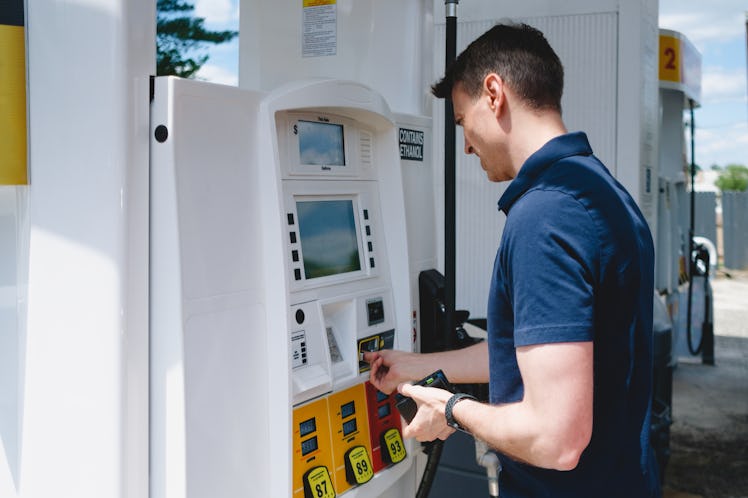9 Tips to Help You Save Gas This Summer
Because with gas prices are this brutal, every little bit counts.

Road trip season is here. But this summer’s brutal gas prices, which are growing worse by the day, are putting a damper on it. In fact, the average price of regular fuel stands at $5.01. In many parts of the country, drivers are shelling out substantially more than that and certain areas are bracing for prices as high as $10 per gallon. It’s enough to make us want to stay home.
At the very least, they should force us all to be more conscious about how much we drive and, more importantly, how we drive. Because there are a few simple behind-the-wheel habits to keep in mind that can help conserve fuel consumption and lessen the strain on your wallet. But what works and what doesn’t? We spoke to a trio of automotive experts who guided us on a few best gas-saving practices to keep in mind.
Pack Smarter
“The lighter your vehicle is, the less fuel you’ll need to accelerate,” says Randy Clements, department head of MINI Product Planning and Aftersales and a 25-year at industry veteran. Clements stresses that what you remove should be significant (it’s about not bringing those three loaded coolers; not about removing one or two sweaters). “Packing light will absolutely have an impact on fuel economy,” confirms Carl Anthony, managing editor of automoblog.net. “Sometimes, for example, people will remove or replace heavy seats to improve fuel economy. Even a slight drop in weight will help.”
Stay Consistent
Speed limit signs are there for your safety as well as your fuel economy. It all comes down to consistency. “If you are constantly working the throttle, changing speeds, or causing the transmission to downshift, you’ll end up using more gas,” says Matt DeLorenzo, senior managing editor for Kelley Blue Book. “AAA reports that reducing highway speeds by 5 to 10 mph can increase fuel economy by as much as 14 percent,” adds Clements. “While all vehicles reach optimal fuel economy at different speeds, a study by the US Department of Energy reports that fuel economy also drops dramatically when vehicles go faster than 50mph.”
Pay Attention to Your Air Filter
Try catching your breath with dirt in your mouth: you wouldn’t run very smoothly either. “Having a clean air filter helps air flow more efficiently through the engine, which improves fuel economy,” says DeLorenzo. “The cleaner, cooler and drier the air entering the engine, the better it will perform,” adds Anthony. As far as changing your filter is concerned? That all depends on how often you drive on dusty or construction-clogged roads. “A good rule is to have your air filter checked every time you change your oil, then replace if necessary,” says Anything.
Use Your A/C. Carefully
“The wind resistance generated by open windows has an adverse effect on aerodynamics, and fuel economy,” says DeLorenzo. “Modern A/C systems have become more efficient, so it’s best to keep the windows up.” That said, cranking the A/C to really cold temperatures can cost you fuel. “It’s just like your home,” he says. “The lower the temp, and the longer it runs, the more it will cost.”
Go Easy on the Accelerator
In terms of saving fuel, smooth and steady is the way to go. “So-called ‘jackrabbit starts’, where you floor the gas and accelerate to high speeds immediately, waste fuel,” says DeLorenzo. In other words, per Anthony, the higher an engine revs, the more fuel it burns.
Mind Your Motor Oil
“At the end of the day, using the correct motor oil, as recommended by the manufacturer, will keep your engine clean and running at optimal performance all around,” says Clements. And optimal performance equals better fuel consumption. Adds DeLorenzo: “Following the manufacturer’s recommended oil guidelines is the best bet for improved fuel economy. It’s the oil they use when certifying the vehicle’s fuel efficiency with the EPA.”
Keep An Eye On Your Tire Pressure
Proper inflation is the key to the best fuel economy. “Overinflated tires may have a lower rolling resistance, but will wear out more quickly,” says DeLorenzo. “So, what you’d save in fuel, you’d more than pay for in a new set of tires. Underinflated tires also cost fuel and cause premature wear. So it’s best to keep them pumped up to the manufacturer’s recommendation.” Confirms Clements: “Properly inflated tires last longer, offer the best possible performance, are safer, and can potentially improve your gas mileage by up to 3 percent in some cases.”
Don’t Draft Trucks
Sure, drafting will lower wind resistance and therefore cut down on fuel consumption, but per DeLorenzo, it’s incredibly dangerous and not worth the risk. “The amount of fuel saved isn’t worth the possibility of an accident.”
Bonus: Download The GetUpside app.
This handy, free app lets you save up to $.25 per gallon on gas, and also offers bonus deals on convenience store items and services such as car washes, oil changes, and more. It also lets you see the cheapest gas prices at more than 2,000 nearby gas stations, and works with major brands such as Shell, Exxon, and BP. Download the app here.
This article was originally published on